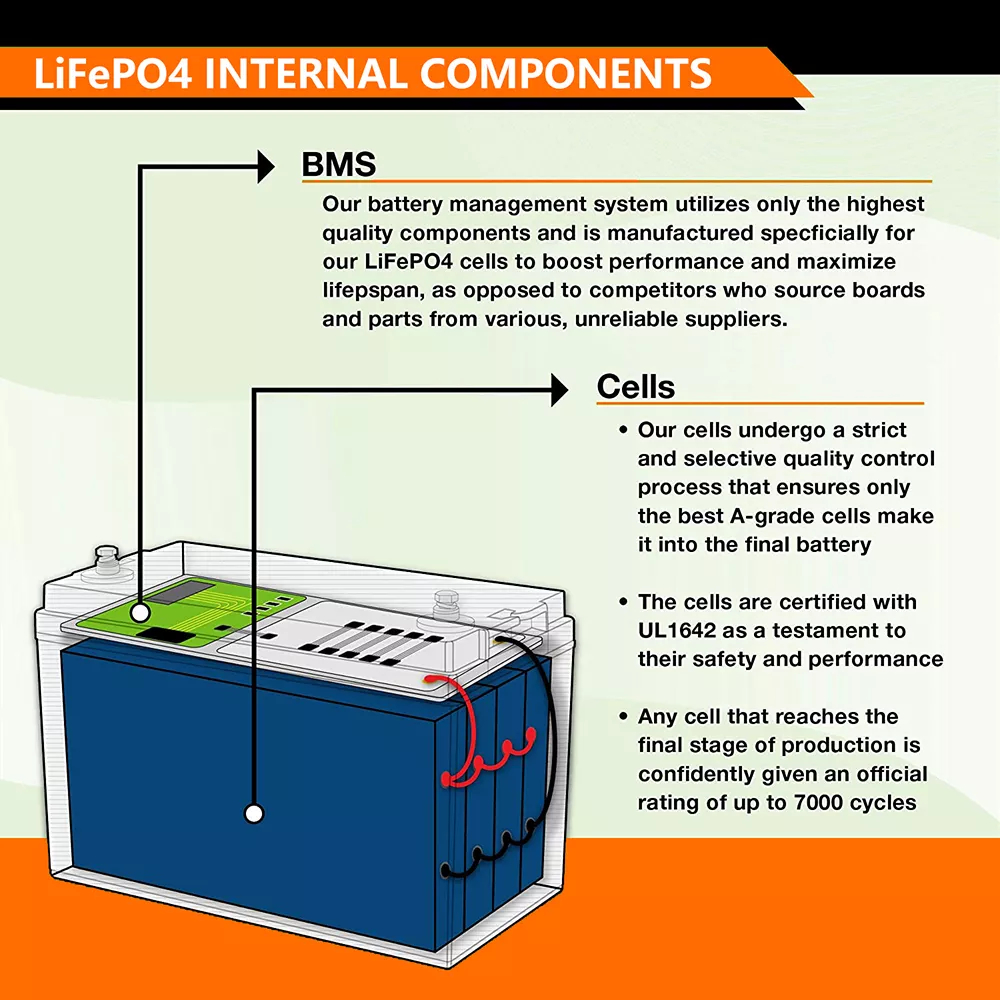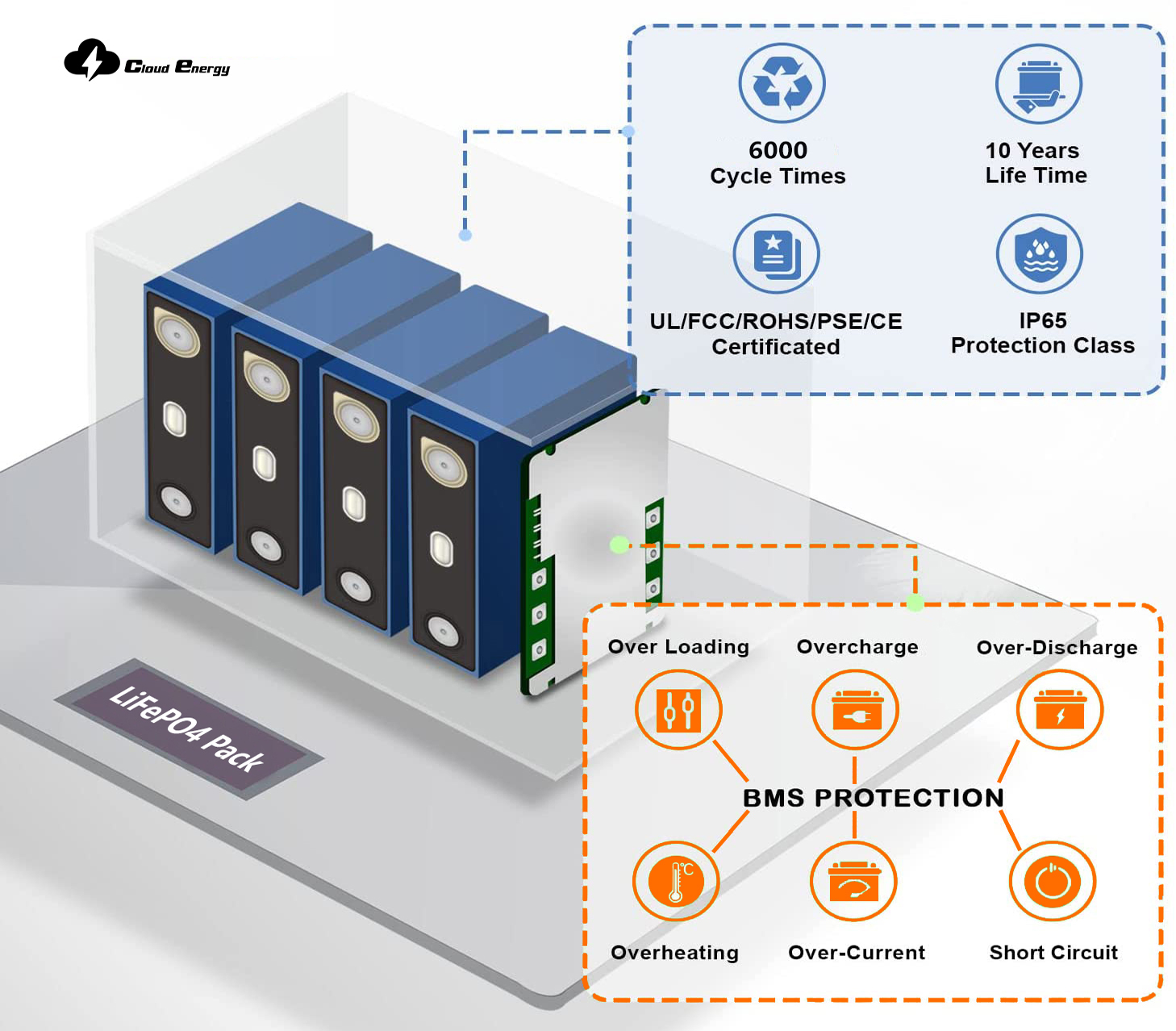By Lester | 23 March 2023 | 0 Comments
Why a Battery Management System is Critical for Lithium Iron Phosphate Batteries

Lithium iron phosphate cells operate safely over a range of voltages, typically from 2.0V to 4.2V. Some lithium chemistries result in cells that are highly sensitive to overvoltage, but LiFePO4 cells are more tolerant. Still, significant overvoltage for a prolonged period during charging can cause plating of metallic lithium on the battery’s anode which permanently degrades performance. Also, the cathode material may oxidize, become less stable, and produce carbon dioxide which may lead to a buildup of pressure in the cell. All Cloudenergy battery management systems limit each cell and the battery itself to a maximum voltage.
Undervoltage during battery discharge is also a concern since discharging a LiFePO4 cell below approximately 2.0V may result in a breakdown of the electrode materials. Lithium batteries have a recommended minimum operational voltage. In the Cloudenergy 12V/150Ah, for example, the minimum recommended voltage is 20V. The BMS acts as a failsafe to disconnect the battery from the circuit if any cell drops below 2.5V.
Overcurrent and Short Circuit Protection
Every battery has a maximum specified current for safe operation. If a load is applied to the battery which draws a higher current, it can result in overheating the battery. While it’s important to use the battery in a way to keep the current draw below the maximum specification, the BMS again acts as a backstop against overcurrent conditions and disconnects the battery from operation.
Again, using the 24V/150Ah as an example, the maximum continuous discharge current is specified at 100A, the peak discharge current is 200A, and the BMS disconnects the battery from the circuit if the load draws about 280A.
A short circuit of the battery is the most serious form of overcurrent condition. It most commonly happens when the electrodes are accidentally connected with a piece of metal. The BMS must quickly detect a short circuit condition before the sudden and massive current draw overheats the battery and causes catastrophic damage. In the 24V/100A, the battery shuts down within 200-600 microseconds of an external short circuit, then resumes normal operation if the short circuit condition is removed.
Over Temperature
Unlike lead-acid or lithium cobalt oxide batteries, lithium iron phosphate batteries operate efficiently and safely at temperatures up to 60oC or more. But at higher operating and storage temperatures, as with all batteries, the electrode materials will begin to degrade. The BMS of a lithium battery uses embedded thermistors to actively monitor the temperature during operation, and it will disconnect the battery from the circuit at a specified temperature. In the example of the Cloudenergy 12V/150A, the BMS disconnects the battery at 80℃(176°F) and reconnects the battery at 50℃(122°F)


Cell Imbalance
Lithium-ion batteries have a major difference from lead-acid batteries when it comes to balancing the voltage in each individual cell during charging. Because of small differences in manufacturing or operating conditions, each cell in a battery charges at a slightly different rate. In a lead-acid battery, if one cell charges faster and reaches its full voltage, the typical low end of charge current, along with the excess charge return, will ensure the other cells get fully charged. In a sense, the cells in a lead-acid battery are self-equalizing during charge.
Lithium-ion batteries have a major difference from lead-acid batteries when it comes to balancing the voltage in each individual cell during charging. Because of small differences in manufacturing or operating conditions, each cell in a battery charges at a slightly different rate. In a lead-acid battery, if one cell charges faster and reaches its full voltage, the typical low end of charge current, along with the excess charge return, will ensure the other cells get fully charged. In a sense, the cells in a lead-acid battery are self-equalizing during charge.
This is not the case with lithium-ion batteries. When a lithium-ion cell is fully charged, its voltage begins to rise further which may lead to electrode damage. If the charge of the entire battery is stopped when only one cell is fully charged, the remaining cells do not reach full charge and the battery will operate below peak capacity. A well-designed BMS will ensure each cell safely and fully charges before the entire charging process is complete.
Lithium iron phosphate batteries are made up of more than just individual cells connected together. They also include a battery management system (BMS) which, while not usually visible to the end-user, makes sure each cell in the battery remains within safe limits. All IMPROVE lithium iron phosphate batteries include an internal or external BMS to protect, control, and monitor the battery to ensure safety and maximum lifetime over the full range of operating conditions.
Leave a Reply
Your email address will not be published.Required fields are marked. *
POPULAR BLOG
- Golf Cart Lithium Battery Replacement for 2013 Club Car Precedent
- Upgrade Your Club Car DS with CloudEnergy Lithium Batteries
- Understanding LiFePO4 Charge Curves: A Comprehensive Guide
- Upgrading Your Golf Cart to Lithium Batteries: A Comprehensive Guide
- What Are the Best Battery Types for Off-Grid Living?
CATEGORIES
TAGS